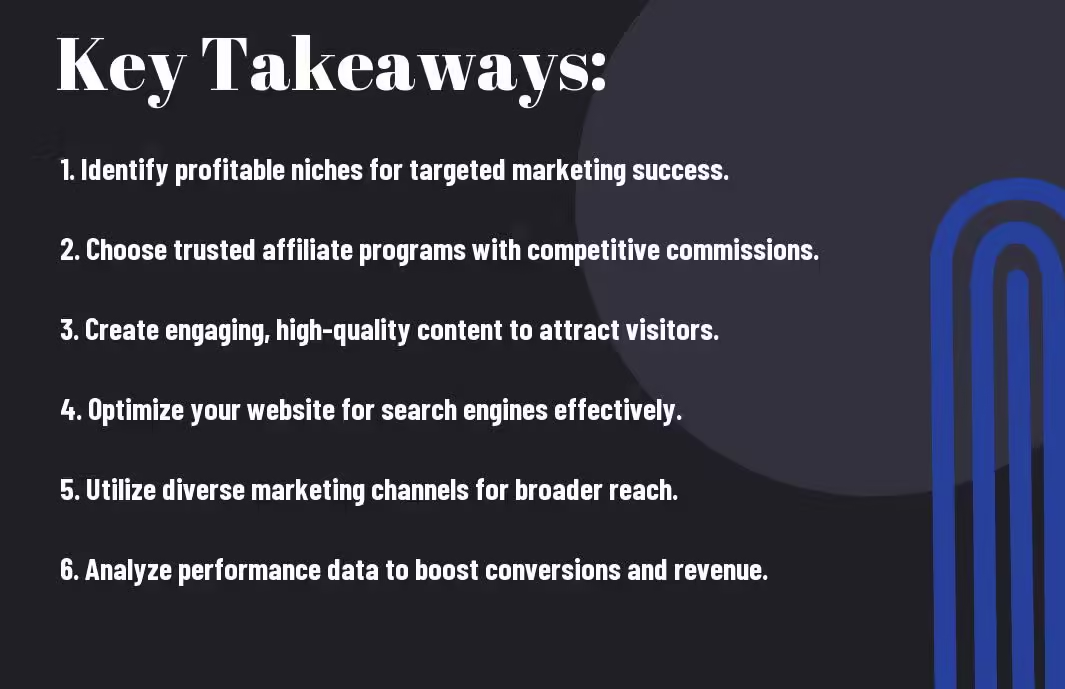Just like you, I started my journey in affiliate marketing wishing to achieve financial independence. In this comprehensive guide, I will share my insights on how you can master affiliate marketing and uncover proven strategies to maximize your earnings this year. Together, we’ll explore the best practices, methods, and tips that will not only enhance your understanding but also set you on the path to successful online income. Join me as we examine into the exciting world of affiliate marketing and make 2025 your breakthrough year!
>>> Mastering Affiliate Marketing the Easy Way <<<

Understanding Affiliate Marketing
A key component of online earning potential is affiliate marketing, a strategy that allows individuals and businesses to generate income by promoting products or services. By joining an affiliate program, you can access a unique affiliate link that tracks your referrals. When someone clicks on your link and makes a purchase or takes a specific action, such as signing up for a newsletter, you earn a commission. This performance-based marketing method not only provides a great way to earn passive income but also allows you to work flexibly without the constraints of traditional employment. In essence, affiliate marketing enables you to profit from promoting products you believe in and that resonate with your audience.
What is Affiliate Marketing?
An affiliate marketing system revolves around the partnership between the product creator and the affiliate marketer. Affiliates are compensated based on the sales or leads they generate through their marketing efforts, creating a win-win situation. This business model has gained immense popularity due to its low barrier to entry and the potential to earn significant income, especially as you refine your strategies and build your audience. By focusing on a specific niche that aligns with your interests or expertise, you can create targeted content that engages potential customers and drives conversions.
How Affiliate Marketing Works
Marketing through affiliate channels begins when you choose a niche and find an appropriate product or service to promote. Once you’re accepted into an affiliate program, you’ll receive a unique link that monitors your traffic and sales. By sharing this link across your blog, social media platforms, or email campaigns, you create opportunities for others to engage with the products you endorse. When a visitor clicks on your link and follows through with a purchase or any other desirable action, the system tracks this interaction and credits your account with the corresponding commission.
At its core, affiliate marketing thrives on building trust with your audience. If you target your promotions effectively and consistently provide value, you can foster a loyal following that appreciates your recommendations. This relationship is key to long-term success in affiliate marketing, as satisfied customers are likely to return and make repeat purchases, directly contributing to your earnings. Ultimately, adopting a strategic, audience-focused approach will unlock unlimited potential in your affiliate marketing journey.
Identifying Profitable Niches
Any successful affiliate marketer understands the importance of finding a profitable niche. It’s not just about random topics; it’s about selecting a specific segment of a larger market that resonates with your passions and expertise. In my experience, exploring into a niche you’re genuinely interested in makes the entire process more enjoyable and sustainable. To uncover viable niches, I suggest leveraging various research techniques that can help you pinpoint trends and demands within your potential market. Utilizing tools such as Google Keyword Planner and SEMrush allows you to explore popular search terms relevant to your interests. This way, you’re not merely selecting a niche based on speculation but grounding your choices in data that highlights areas of demand.
Research Techniques
Identifying the right audience is pivotal to affiliate marketing success. One effective method I’ve found is to engage in social media listening and forums related to your niche. By tapping into platforms like Reddit or various Facebook groups, you can gauge what products or services people are actively discussing and looking for. Additionally, looking at Amazon Best Sellers or eBay trending sections can give insights into what items are capturing consumer attention. Doing thorough keyword research will not only reveal what people are searching for but also provide insights into low-competition niches that might prove to be lucrative for you.
Analyzing Competition
Niches can be rewarding, but they often come with their own level of competition. It’s wise to analyze your competitors to understand what strategies they are using and how you can differentiate yourself in the market. I like to take notes on the content, design, and engagement levels of competitor websites. This deep dive allows me to see what’s working well for them and where there might be gaps I can exploit to provide unique value. A thorough competitive analysis can give you the edge in choosing the right products to promote and optimize your marketing strategies accordingly.
Further information about analyzing competition can help you develop a clear understanding of where you stand in the market. Observing your competitors’ performances, their marketing tactics, and their customer interactions will equip you with the knowledge to make informed decisions. You’ll also want to avoid overcrowded spaces that may slice into your profits and instead look for opportunities where you can innovate or establish better customer engagement. Ultimately, recognizing both the strengths and weaknesses in your competitors allows you to carve out your unique brand identity in affiliate marketing.

Choosing the Best Affiliate Programs
Your journey into affiliate marketing will largely depend on the quality of the affiliate programs you choose to join. Evaluating program quality is vital to ensure that you’re partnering with reputable companies that not only offer valuable products but also provide solid support for their affiliates. Across the vast landscape of affiliate programs, you’ll come across varying degrees of support and reliability. Focus on programs that are well-established and have a history of positively engaging with their affiliates. Look for those that offer comprehensive marketing materials, solid tracking tools, and responsive affiliate management, as these factors contribute to a more successful affiliate marketing experience.
Evaluating Program Quality
Across the numerous options available, start by investigating the program’s reputation and track record. Solicit feedback from existing affiliates and utilize online forums to gather insights on their experiences. Does the program have positive reviews regarding prompt payments and support? Being diligent in this assessment can save you from potential headaches down the line and ensure that you align yourself with a trustworthy program.
Comparing Commission Structures
Above all else, the commission structure of affiliate programs plays a significant role in your potential earnings. As you analyze these structures, consider not just the percentage of each sale but also how the program structures its payouts. Assessing how and when commissions are paid, such as through monthly or bi-weekly payments, is equally important to maintaining your cash flow. Here’s a comparison of common commission structures:
| Pay Per Sale (PPS) | You earn a commission when a sale is made through your affiliate link. |
| Pay Per Lead (PPL) | You earn a commission when a prospect becomes a lead, such as signing up for a newsletter. |
| Pay Per Click (PPC) | You earn a small fee for each click generated through your affiliate link. |
Choosing the right commission structure is vital for maximizing your revenue potential. Some programs may offer a higher percentage per sale but have lower volume, while others may provide lower commissions but with a higher sales frequency. Focus on finding a balance that aligns with your marketing strategy. Additionally, pay attention to any hidden fees or conditions that may impact your overall earnings. By selecting affiliate programs that resonate with your target audience and fit your marketing style, you can pave the way for sustained success in your affiliate marketing endeavors.
| Commission Rates | Understand the average commission for your niche to ensure competitiveness. |
| Payment Frequency | Know when to expect your commissions to manage your income effectively. |
| Cookie Duration | Longer cookie durations can improve the likelihood of earning commissions. |

Creating a High-Impact Affiliate Website
Keep in mind that your affiliate website is the cornerstone of your online marketing efforts. A well-designed website not only attracts visitors but also encourages them to take action, whether that means clicking on your affiliate links, signing up for your email list, or making a purchase. By focusing on user experience and aesthetic appeal, you can significantly enhance the likelihood of conversions. With the OLSP method guiding your actions, I recommend prioritizing a clean layout, intuitive navigation, and mobile responsiveness. This ensures that visitors can easily find what they’re looking for and are more likely to engage with your content.
Website Design and User Experience
User experience can make or break your affiliate marketing journey. It’s vital to create a website that is not only visually appealing but also functional. This means using a responsive design that adapts seamlessly to various devices, including smartphones and tablets. Additionally, I suggest organizing your content with clear headings and easy-to-read fonts to enhance readability. A well-structured website keeps your audience engaged and decreases bounce rates, which is vital for SEO. Your goal should be to create a smooth and hassle-free experience that allows users to find information quickly and efficiently.
Crafting Compelling Content
An effective affiliate marketing website is built on high-quality, compelling content that resonates with your target audience. I found that creating valuable content not only attracts visitors but also establishes your authority within your niche. This includes writing informative blog posts, product reviews, and tutorials that speak to the needs and interests of your audience. By focusing on how products can solve specific problems, you can increase the chances of driving conversions. Aim to engage your audience emotionally and intellectually, allowing them to see the value of the products you endorse.
Also, integrating your affiliate links naturally within your content is vital for maintaining credibility. Overstuffing your site with links can turn off readers and may violate affiliate program terms. Instead, I recommend strategically placing links where they flow naturally within the text. For instance, when discussing a specific product feature, including a link for readers to purchase it directly enhances user experience and prompts action. Ultimately, your content should not only inform but also inspire your audience to take the next step in their buying journey.
Effective Marketing Strategies for Affiliates
Once again, implementing effective marketing strategies is vital to the success of your affiliate marketing efforts. With the ever-evolving landscape of online marketing, I have found that diversifying your approach can yield significant results. By leveraging a combination of social media platforms, search engine optimization (SEO), and paid advertising, you can drive targeted traffic to your affiliate offers. Each method serves a unique purpose and can enhance your visibility, increase conversions, and ultimately maximize your income potential as an affiliate marketer.
Leveraging Social Media
By harnessing the power of social media, you can tap into vast audiences that could be interested in your affiliate products. Platforms like Facebook, Instagram, Twitter, and Pinterest allow you to build a community around your niche, engage with your audience, and share content that promotes the products you love. I often find that consistently posting engaging and valuable content will not only attract followers but also establish your credibility as an affiliate marketer. Utilizing stories, reels, and live streams can create a more personal connection with your audience, leading to higher engagement rates.
Utilizing SEO and Paid Ads
Across my journey in affiliate marketing, I have learned that combining SEO with paid advertising can significantly boost your affiliate earnings. SEO focuses on optimizing your content to rank high on search engines, which drives organic traffic to your site. It involves using keyword research to find terms your audience is searching for and creating high-quality content around those keywords. On the other hand, paid ads allow you to reach a broader audience quickly. While they require an investment, the potential return on that investment can be substantial if done correctly.
And when you pair effective SEO practices with well-targeted paid ads, you create a synergy that can significantly amplify your online presence. For instance, investing in Google Ads allows you to place your affiliate offers in front of users actively searching for similar products, increasing the likelihood of conversions. It’s necessary to monitor the performance of your ads and optimize them regularly. Use tools like Google Analytics to track your ROI and identify what works best for your audience. With the right mix of sustained SEO efforts and strategic paid advertising, you can elevate your affiliate marketing game and see tangible results in your earnings.

Tracking Performance and Optimization
Unlike traditional marketing methods, affiliate marketing thrives on data and analytics. To truly harness the power of your affiliate efforts, it’s imperative to track performance meticulously, allowing you to make informed decisions that can enhance your success. By implementing effective tracking strategies, you will be able to see which campaigns are driving sales and which areas require improvement. For a deeper examine the ins and outs of affiliate marketing, I recommend checking out Mastering the Art of Affiliate Marketing: Essential Tips for Achieving Business Success in 2025. This resource can provide insights that will boost your affiliate marketing journey.
Setting Up Analytics Tools
One of the first steps I took in optimizing my affiliate marketing strategy was setting up robust analytics tools. Utilizing platforms like Google Analytics allows you not only to track the traffic directed through your affiliate links but also to analyze user behavior on your site. From tracking referral sources to monitoring conversion rates, these insights will provide a comprehensive view of what attracts your audience and what doesn’t resonate with them. This data empowers me to adjust my strategies effectively, improving my campaigns and increasing my overall revenue.
Increasing Conversion Rates
Performance is the heartbeat of affiliate marketing, and understanding how to boost your conversion rates can significantly impact your earnings. To achieve high conversion rates, focus on creating compelling calls to action and strategically positioning your affiliate links within your content. I often conduct A/B tests on landing pages to determine which elements are most effective at appealing to my audience. Small adjustments, such as changing the color of a button or rephrasing a tagline, can lead to notable increases in conversions.
Hence, enhancing your conversion rates is about fine-tuning your approach based on data-driven insights. I’ve learned that by personalizing the user experience and providing genuine value, I can establish trust and credibility. This trust encourages visitors to click on my affiliate links and make purchases, leading to increased commissions. By investing time in understanding user preferences and adjusting my strategies accordingly, I’ve seen significantly improved results in my affiliate marketing efforts.
Mastering Affiliate Marketing: Your Ultimate Guide to Achieving Success in 2025
Hence, as I conclude this comprehensive guide on mastering affiliate marketing, I want to emphasize that your journey to success in 2025 starts with a clear understanding of the principles and strategies outlined throughout this resource. By grasping the fundamentals of affiliate marketing, identifying profitable niches, and selecting the right affiliate programs, I believe you can set the foundation for a thriving online business. Embrace the learning process, remain adaptable to changes in the industry, and consistently engage with your target audience to build trust and credibility.
Your path in affiliate marketing is filled with opportunities, and I encourage you to take actionable steps toward turning your aspirations into reality. Utilize the marketing strategies discussed, optimize your online presence, and track your performance diligently. Success won’t happen overnight, but with persistence and dedication, you can create a sustainable income stream through affiliate marketing. So, take the plunge, apply what you have learned, and watch as you transform from a beginner to a successful affiliate marketer in 2025 and beyond.
>>> Learn Affiliate Marketing the easy way! <<<
FAQ
Q: What are the first steps to start affiliate marketing?
A: To start your journey in affiliate marketing, first identify your niche, which is a specific segment of the market that you are passionate about or have knowledge in. Research that niche to understand its demand and competition. Next, sign up for reputable affiliate programs that align with your niche—look for programs that offer good commission rates and provide marketing resources. Once you have your affiliate links, create a dedicated platform such as a blog or website where you can promote the products effectively. Engage with your audience through high-quality content, and utilize various marketing strategies, like social media and email marketing, to drive traffic to your affiliate offers.
Q: How do I choose the right affiliate programs to partner with?
A: Selecting the right affiliate programs begins with evaluating the reputation of the program and the products being promoted. Look for programs that have a solid track record and positive testimonials from affiliates. Assess the commission rates offered—higher rates typically indicate better potential earnings. It’s also important to consider the payment methods available, such as PayPal or bank transfers, as well as the frequency and timeliness of payments. Ensure that the products match your audience’s interests and that the program provides effective marketing support, including promotional materials and tracking tools.
Q: What are some effective strategies for driving traffic to my affiliate website?
A: To effectively drive traffic to your affiliate website, consider a mix of organic and paid strategies. Start with SEO (search engine optimization) techniques—optimize your content with relevant keywords, improve your site structure, and create backlinks to increase your site’s visibility on search engines. Leverage social media platforms by sharing engaging posts and articles that link back to your site. Email marketing is also highly effective; build an email list and send newsletters with valuable content and affiliate offers. Paid advertising, such as PPC (pay-per-click) ads, can help bring immediate traffic, particularly when targeting specific audiences looking for related products.
Q: How can I optimize my website for better conversions?
A: Improving conversions on your affiliate website involves several key strategies. First, ensure that your website is user-friendly with a clean design and intuitive navigation. Use compelling call-to-action (CTA) buttons that clearly direct visitors on what to do next. Incorporate engaging and informative content, such as product reviews and comparison guides, that help visitors make informed decisions. Utilize split testing to determine which elements of your site work best, such as different layouts or CTAs. Additionally, include testimonials and social proof to build trust with your audience, encouraging them to take action.
Q: What common mistakes should I avoid in affiliate marketing?
A: To be successful in affiliate marketing, it’s important to avoid certain pitfalls. One common error is promoting irrelevant products that do not align with your niche or audience interests—this can lead to poor engagement and conversion rates. Also, neglecting proper disclosure of affiliate relationships can damage your credibility and violate legal requirements. Focusing solely on a single income stream can be risky; diversify your affiliate partnerships to mitigate potential losses. Lastly, failing to continually monitor and adjust your strategies based on performance data can stifle your growth; stay adaptable and informed by utilizing analytics tools to track your progress.














